In the distance, far from my slowly moving vehicle along Myakka River State Park’s main road, tall, strange silhouettes of robust birds were slowly making their way across the asphalt. Their characteristic strut, reddish-heads, and iridescent feathers told me that these peculiar animals were wild turkeys- what a treat! As the fascinating birds walked on long legs from floodplain to forest, I stopped my vehicle and pulled out my binoculars to get a closer look at the large group. An amused onlooker yelled from their car- “right on time for Thanksgiving!”
While both wild and domesticated species of turkeys are often the brunt of jokes about upcoming holiday meals, there is much more to “gobble gobble” than you may think! Keep reading to learn more about wild turkeys. For information about a variety of other wildlife species, read other blogs in our Wild Sarasota blog series, or explore our Florida Wildlife Webpage.
Florida’s Wild Turkey Species
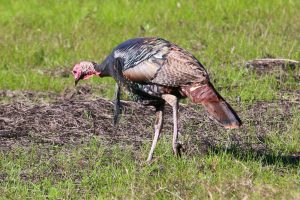
The wild turkey (Meleagris gallopavo) is found year-round throughout the United States, parts of Mexico, and some areas of Canada. There are a variety of domesticated turkey species around the world that are most commonly sold commercially, and are likely the ones consumed by most people.
In the state of Florida, two native sub-species are present. They are the Eastern wild turkey (Meleagris gallopavo silvestris), found north of the peninsula and in the panhandle, and the endemic Florida or Osceola wild turkey (Meleagris gallopavo osceola), found only in peninsular Florida. The latter species was named after Muscogee (Creek) and later Seminole warrior Billy Powell, known as Asi-yahola (English spelling: Osceola), who led the resistance against the forced relocation of Seminole people to Western reservations (National Park Service, 2021).
Identifying the Florida Wild Turkey
Wild turkeys belong in the order Galliformes, and the family Phasianidae. Similarly to other members of their order and family, wild turkeys are heavy-bodied, have shorter wings, and are primarily ground-dwelling (NHPBS, n.d.). While the Eastern and Florida wild turkeys can look quite similar, the Florida wild turkey is generally smaller and darker in color than the Eastern wild turkey, with a greener iridescence to its feathers. Here are a few helpful identification tips and physical characteristics for our local subspecies, the Osceola or Florida wild turkey:
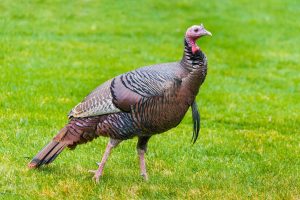
- ~3.5 feet tall
- Long legs with chicken-like skin and feet
- Chestnut brown and black body with green, blue, and red iridescent feathers
- Fan-shaped tail feathers
- Flight feathers with narrow white bars (Eastern wild turkeys have more pronounced white barring on their flight feathers)
- Female turkeys duller and more evenly brown
- Male turkeys possess the iconic, dramatic red wattle, fleshy caruncles, a long, flesh-like extension called a snood that grows from the forehead, and a wispy, hair-like projection of dark colored feathers that hangs from the chest called a beard.
- Females may have less dramatic wattles, caruncles, and snoods, as well as a small beard.
- Spurs, or long, sharp, dagger-like keratinous appendages, are present on the backs of male turkey legs, with those of females generally resembling smaller bumps.
Habitat

If you are looking for opportunities to view Osceola turkeys in action, be warned that these intelligent and aware animals have great eyesight and hearing, and are easily spooked. Quietly observe them from afar to avoid scaring them off. Due to their varied, omnivorous diet and nomadic nature, turkeys can utilize many of Florida’s habitats. They prefer open woodlands, forested areas, flatwoods, and swamps, with differing amounts of coverage for nesting, roosting, finding mates, and more (USDA NRCS, 2022).
Aside from the availability of a good food source, an important characteristic of preferred turkey habitat is an environment that offers good visibility and reduces hiding places for predators to stealthily approach turkeys. Visit a Sarasota County Preserve or Myakka River State Park for a chance to observe these fascinating birds.
Breeding and Reproduction
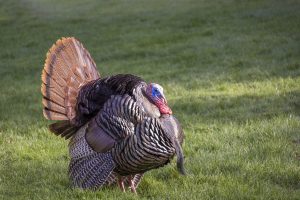
Come springtime in Florida, the male turkey, also known as a “tom”, uses its unique accessories to attract females to breed with. Males will head to a visible location to display themselves together as a flock in hopes of drawing out interested females (Krakauer, 2020).
As if strutting, making their characteristic, resounding “gobble”, spreading their fan shaped tail, and puffing their feathers out to display beautiful, shimmering jewel and earth-toned colors was not enough to woo nearby females or “hens”, a male turkey’s wattle and caruncles will flush with blood and become enlarged and bright red. Their featherless head even assumes an electric blue hue!
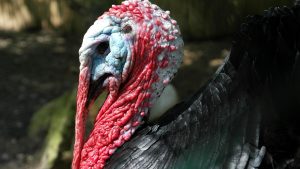
After mating, females head off on their own to scratch shallow depression nests on the ground amongst leaf litter. In Florida, around 9 to 12 eggs are laid beginning around late March, and are incubated by the female alone for approximately 26-28 days (FWC, n.d.).
Behavior and Diet

Wild turkeys are quite social birds, and can be found traveling in medium to large flocks with a clear “pecking order”. Members of the flock generally yield to larger, more dominant females or males. Flocks are usually separated by sex, with hens and their young sticking together, and toms forming their own flocks. Turkeys make a wide range of vocalizations with different meanings and purposes. You can listen to recordings of many of their calls and learn what those calls are communicating here.
While some may think that these plump members of the class Aves do not fly, wild turkeys have strong wings that are capable of carrying their bodies at speeds of up to 55 mph (FWC, n.d.). When night falls, wild turkeys will fly into tall trees to roost off the ground, where they are protected from predators.
Despite having the ability to fly, they prefer to travel by land on their strong feet and long legs, scratching the soil as they forage through open woodlands for vegetation, fruits, nuts, seeds, macroinvertebrates, and small reptiles and amphibians. As somewhat nomadic omnivores, wild turkeys can cover large areas as they follow what’s “in season”.
A Note About Feeding Wild Turkeys
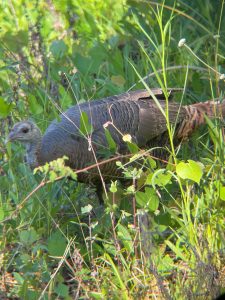
Even though wild turkeys eat a wide variety of foods, it is not a good idea to intentionally feed them. These animals have access to plenty of nutritious foods in their habitat, and human foods can be harmful or nutritionally insufficient. Additionally, feeding turkeys and other wildlife in general encourages them to associate humans with food, to approach humans, and to frequent human communities. As a heavy bird that can stand over half the height of the average human, and one that can possess sharp, defensive spurs on the backs of their legs, wild turkeys can do some damage!
The Florida Fish and Wildlife Conservation Commission also recognizes that part of a turkey’s natural behavior (and ecological function) is to move across the landscape as they forage. Feeding them encourages turkeys to congregate in areas rather than moving on, increasing the spread of disease and fighting amongst flocks (FWC, n.d.). Learn more about best practices when living with wild turkeys.
More Than Just a Turkey Dinner
Wild turkeys play an important role in the ecosystems they inhabit as prey for a wide variety of other native wildlife, from egg to adult. Additionally, as omnivorous foragers, they may contribute to the control of insect and other pest populations.
With their intelligence, unique physique, social life, and courtship behaviors, wild turkeys certainly are more than just a “turkey dinner”. For those who happen upon them, these animals are a delight to observe in Florida’s natural areas.
Learn More
I hope you have enjoyed learning about wild turkeys! Learn more with these resources:
- Cornell Lab All About Birds: Wild Turkeys
- Golden Gate Bird Alliance: The Secret Lives of Turkeys
- Audubon News: Let’s Talk Turkey Beards
Read all our Wild Sarasota blogs HERE.
***The Florida Fish and Wildlife Conservation Commission is undertaking a summer survey for wild turkeys. From June 1st-August 31st, report your wild turkey sightings here.
Resources
Florida Fish and Wildlife Conservation Commission. (n.d.). Florida Wild Turkey Models. https://myfwc.maps.arcgis.com/apps/webappviewer/index.html?id=8b4862e543bc4fc38a244162761af186
Florida Fish and Wildlife Conservation Commission. (n.d.).Wild Turkeys. https://myfwc.com/wildlifehabitats/profiles/birds/game-birds/wild-turkeys/
Krakauer, A. (2020, November 23). The Secret Lives of Turkeys. Golden Gate Bird Alliance. https://goldengatebirdalliance.org/blog-posts/the-secret-lives-of-turkeys/
National Park Service. (n.d.). Osceola. https://www.nps.gov/people/osceola.htm
National Wild Turkey Federation. https://www.nwtf.org/
New Hampshire PBS. (n.d.). Phasianidae – Pheasants, Turkeys, Grouse. https://nhpbs.org/wild/phasianidae.asp#:~:text=They%20have%20plump%20bodies%20and,in%20nests%20on%20the%20ground.
USDA Natural Resources Conservation Service. (2022, September). Wild Turkeys Thrive in Fire-maintained Habitats. https://www.nrcs.usda.gov/sites/default/files/2022-09/Prescribed%20Burning%20and%20Wild%20Turkeys%20NRCS%20partners%20handout.pdf
 1
1
